
A New Style for the New Internet
Dom explores how the values and aesthetics of the internet are shifting in the age of AI and decentralization. The piece argues that the next wave of digital products will need to move beyond modernist minimalism, embracing more expressive, context-rich, and community-driven styles that reflect the deeper values of the new online era.
By: Dom
The new internet needs a new style.
You can feel this growing sense in the recent fixation on the word “taste”. As AI tools relentlessly set new benchmarks and the moat of technical skill dissolves, we are looking for a new measuring stick. Taste is a level of abstraction above skill. It’s no longer enough to build something that only functions, it needs to be tasteful and cool. It needs an aura about it, a point of view.
But what does having taste really mean? Ruby Justice Thelot, in his recent release “A Few Essays on Taste”, cites three ingredients, which form a path: knowledge, curiosity, and love. To have taste is to go beyond having a cerebral understanding of something, or even a deep curiosity, but to fall for it, head over heels. This sense of loving something for its own sake is so far altogether missing from the productization of “taste” as a new tactic in the startup game.
And even as a tactic, it falls short when everyone has the same taste.
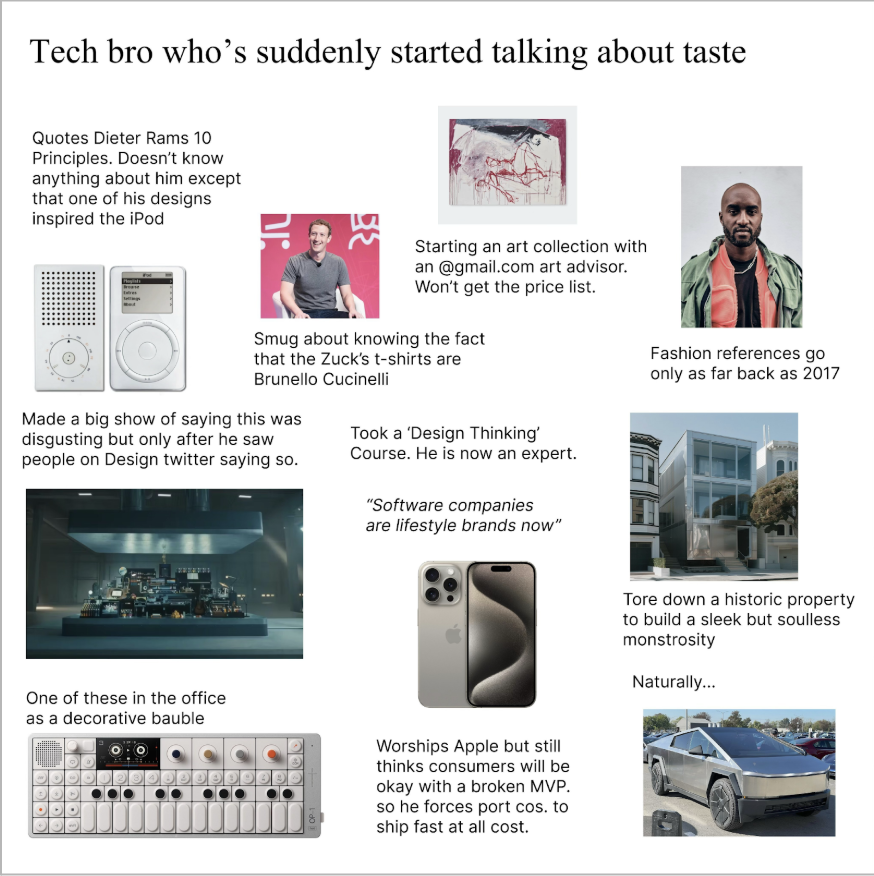
By Edmond Lau
Design references in tech are shallow: Rams, Norman, Jobs and Ive, IDEO, Material Design. They largely constitute a single thread that reaches back to the Bauhaus and the rise of Modernism, movements that in art and architecture were rejected 50 years ago.
The current taste discourse misses the realization that styles are not neutral; form embeds values. Taste is a moral-aesthetic orientation. As a thing is designed, decisions are made. Repeated decisions over time cause heuristics to emerge, and these heuristics manifest a stable identity, a style, which can then become a collective endeavor. The progression of the avant-garde in a discipline like architecture can be thought of as an evolutionary march of styles, each reflecting and encoding something of the defining spirit of the time.
By participating in a style you propagate the values which drove its genesis. Modernism started as a techno-utopian vision for a global world, net new and free from any ties to tradition or excess. In architecture this manifested as the skyscraper — the tall box — a form that in its utter simplicity and economy was thought to fit anywhere in the world, regardless of climate, culture, or geography. “The International Style” was functional, efficient, and minimal – and it scaled extremely well. By 1975, more than 170 million apartments were built across the world in this style, housing one in eight humans globally. This cultural and aesthetic flattening led to the style’s rejection as dehumanizing, authoritarian, and fascist, eventually being challenged by Postmodernism’s embrace of symbol and irony (Robert Venturi’s “less is a bore”). A great number of Modernist apartment blocks have been dynamited in the decades since.
Virgil Abloh, who has become an avatar among tech bros for signaling that you have taste, was notably a Postmodernist. His work revolved around irony, pastiche, and reference. Despite his presence as an avatar, however, there’s a lack of any tangible influence on the wares of Silicon Valley. Dada fundamentally clashes with the Apple Store. In this way, the signaling power of Virgil reveals that the tech industry has yet to seriously question the tenets of Modernism the way architecture did. There’s a single unbroken Modernist thread that runs from the Bauhaus to Dieter Rams to Jony Ive.
This extends to the major app platforms of the 2010’s. Their design is rooted in function and global scalability. And they are vulnerable to the same problems of cultural flattening and dehumanization as architecture’s International Style. In the same way standardized boxes were an efficient way to house humans, standardized content is an efficient way to monetize their attention. Much like a few European architects dominated the design of urban areas in the mid 20th century, a few massive corporations dominate the design of the internet today, with their in-house aesthetics framing and shaping the form and character of most of humanity’s online activity.
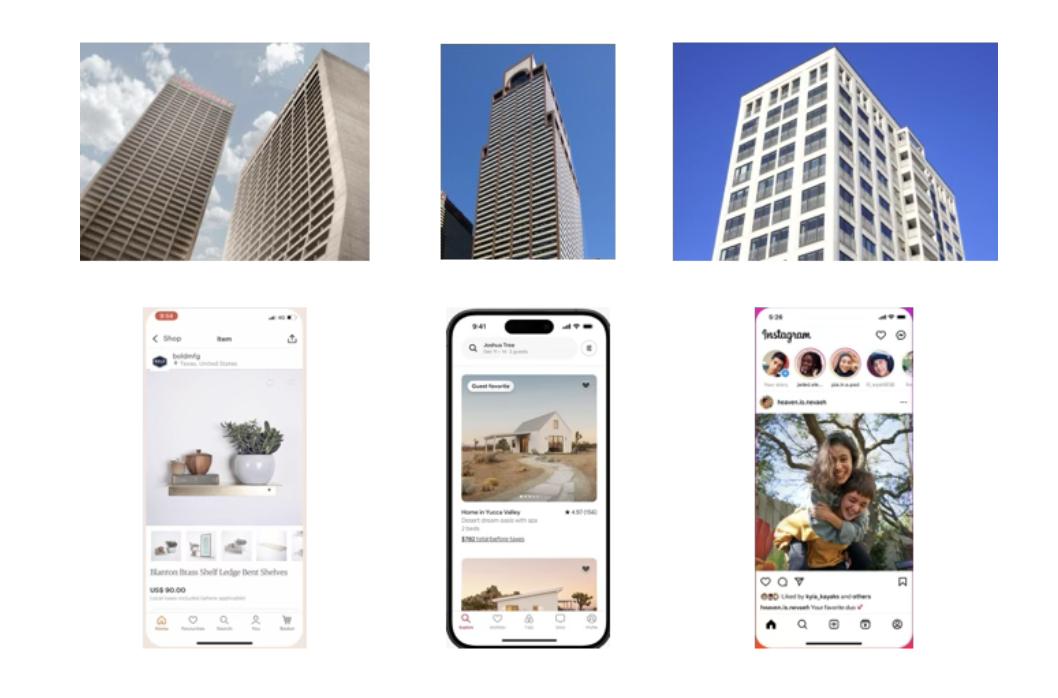
Top: The International Style in South Africa, Jakarta, Munich
Bottom: Design Thinking in Etsy, AirBnB, Instagram
Modernism is the visual language of centralization. But the new internet needs a new style.
If a blockchain is anything, it’s a decentralizing force. A disintermediator. Its values are in tension with Modernism: self-sovereignty, community ownership, composability, open networks. These arrangements present different design problems which will necessarily manifest a different style. Crypto apps shouldn’t look or operate like their predecessors , because they’re driven by fundamentally different incentives and forces. Content on instagram is stripped of its context and particularity so that it can be easily monetized with ads. Content on an onchain social app can be monetized directly with a peer-to-peer transaction. This absence of rent-seeking incentivizes the creator to make content that has more context, meaning, personality, and authenticity — to foster a direct relationship with their fans and community members over an indirect relationship with advertisers mediated by the platform.
Tech’s lack of real engagement with the broader canon and evolution of art & design has caused its style to stagnate. To work out a new style it needs to embrace new references. One of particular note that is completely ignored is the Arts & Crafts movement, a counterculture to industrialization in 19th century England that rejected the aesthetic corruption and dehumanizing work that came with the rise of the factory. The movement embraced localism, craft, the personal judgment and agency of the maker, and cooperative structures of organization inspired by Medieval guilds.
The manifesto for this movement is found in John Ruskin’s “The Stones of Venice”. In the chapter “On the Nature of Gothic”, Ruskin examines the architecture of Medieval Venice, which was looked down on as crude and unrefined. To him, these imperfect aspects were signs of the vitality and agency of the craftspeople of the time, in sharp contrast to the Victorian factory workers who had been stripped of their agency and judgement and treated like a machine.
Our time shares a lot in common with Ruskin’s, but in an inverted way. The frontier tech of 19th century England was the stocking frame, a machine that eroded the agency of lifelong weavers by mechanically imitating their movements. At least some of the frontier tech today — AI agents, composable crypto primitives — are paradoxically tools that can increase the agency of their users. They allow the individual to exercise their autonomy, creativity, and to shape the environment around them in an expressive way. The judgement and care of the 19th century craftsperson is now the taste and prompts of the vibe coder.
Ruskin names six qualities that are characteristic of Gothic style and shows how they they reveal a vibrant Medieval ecosystem of builders A close reading of these qualities open up surprising parallels to the onchain builder landscape today, and potentially unlocks new mental models for how to think about the new internet:
Savageness
Venetian architecture was criticized as imperfect and crude. The sculptural details on the Palazzo Ducale, for example, are highly irregular and uneven. Ruskin saw this as proof that the artisans were given the room to improvise on the job instead of being directed explicitly. The column capitals are filled with expressive and varied carvings that speak of the taste of the person who made them.

Column capitals from the Palazzo Ducale, Venice
In the current startup landscape, shipping fast and building in public is in some ways a similar savageness. Rather than polished corporate releases, there’s a kind of expressive crudeness that signals a wider participation of builders and a vital ecosystem
Changefulness
Gothic architecture embraced continuous variety. Cathedral windows repeat the same overall structure, but each is unique. The open-source structure of crypto, with easily fork-able primitives and permissionless frontends, naturally lends itself to this kind of composable variety over the sanitized and monotonous consistency we see in mega-platforms.
The recent flourishing of the token launcher is a good example. New launchers have been widely criticized (“do we really need another token launcher?”), but this critique misses the point. A lot (though not all!) of these launchpads are operating within different sub-communities with different ideas on what a token should be. Fungible tokens are not fungible in their context, their purpose, and their community. While many builders are looking to outcompete each other and become the dominant token launch platform, the unlock may be to focus on a niche community with a unique point of view on how tokens can be used in new ways.
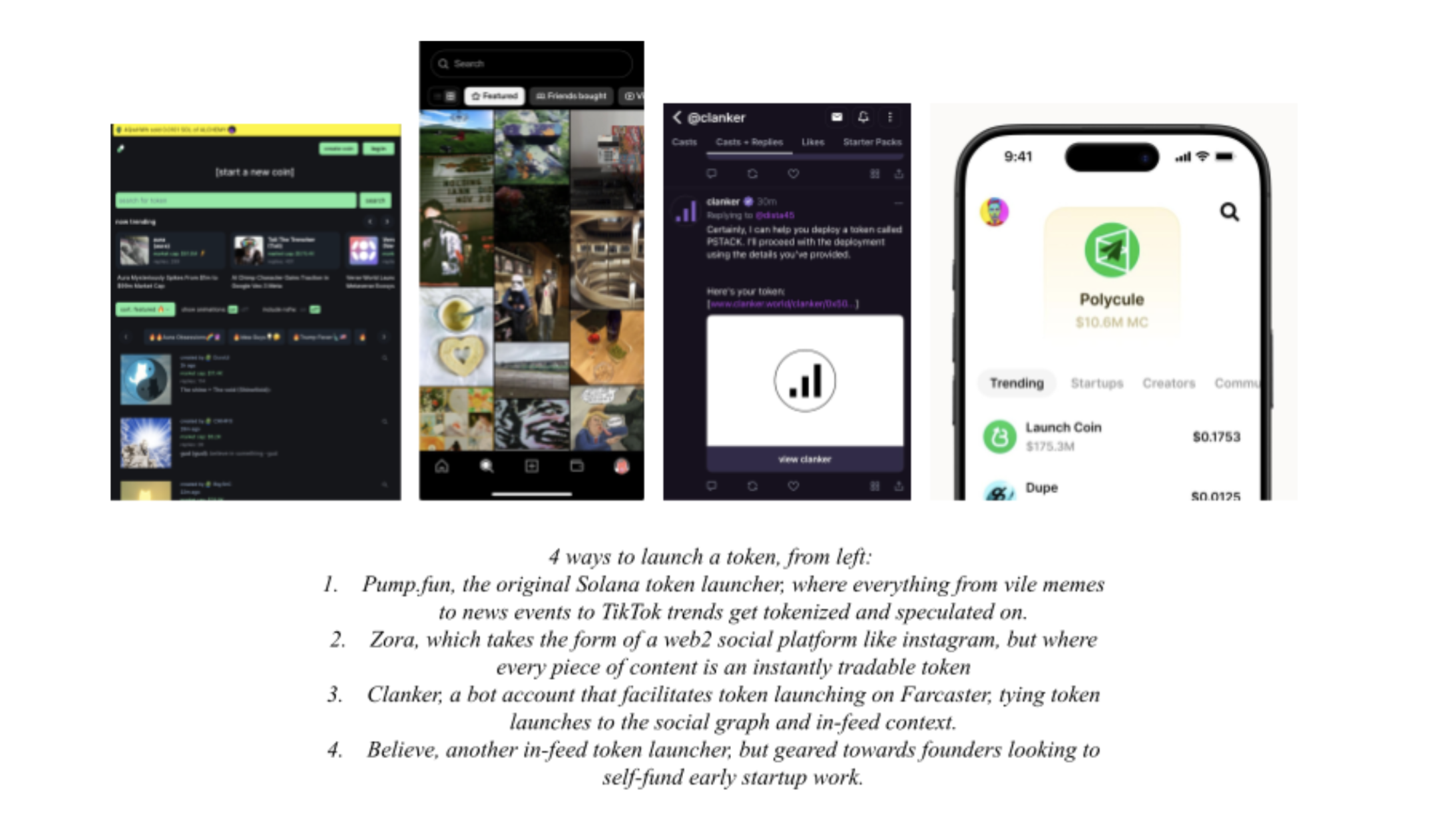
Naturalism
The Gothic rejected the copying of generic Roman or Greek ornamental motifs, and instead encouraged the direct observation of natural forms of life in their chaotic irregularity. This grounded, honest naturalism was a sign that artisans were engaged with the living world, the source of all inspiration, on their own terms, as opposed to executing a predetermined formula.
We can attempt to make a comparison to the blockchain as a kind of new nature. “Check the chain” is thrown around often as a reminder that your onchain activity is public. As more of the world’s activity moves onchain, imaginative observation of this data will only become more fruitful for builders.
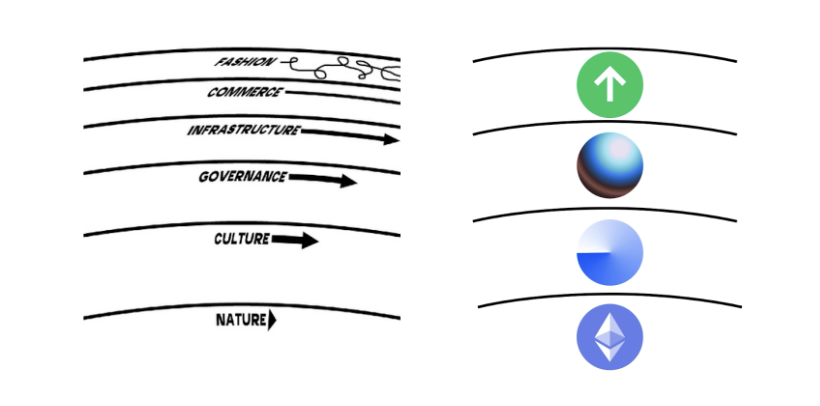
Stewart Brand’s Pace Layers, Ethereum’s Pace Layers
Grotesqueness
Figures in Gothic art and architecture were often hybrid, deeply weird, and darkly humorous. What some saw as disturbing Ruskin saw as a sign of unpoliced imagination. The grotesque is not hard to find in crypto. Pfp projects, memes, telegram stickers, these are the gargoyles of Web3 Gothic. They are representations of the mind dealing with the unknown. Many builders simply dismiss this part of crypto culture as “degen” and hope it goes away, but these digital grotesques carry narrative weight that can sometimes contain valuable signal about what is brewing in the culture.
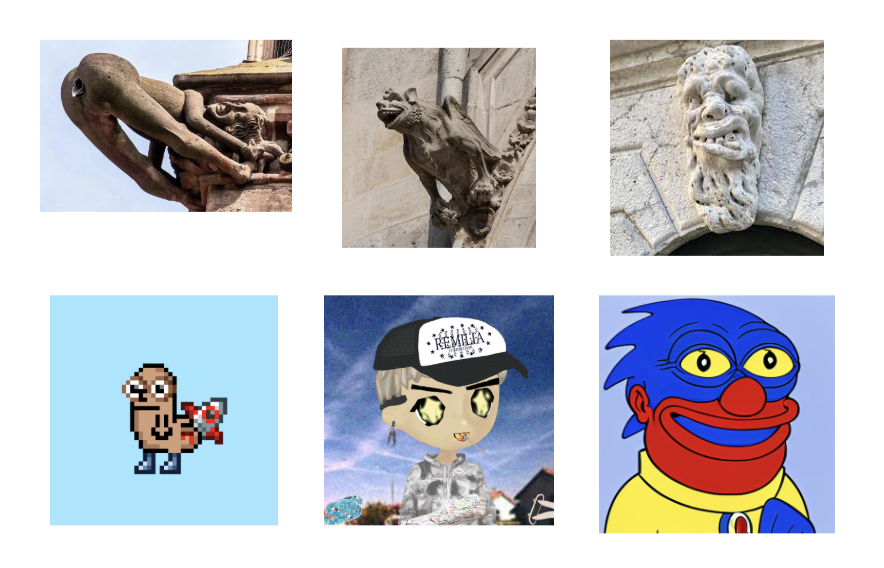
Top row: Medieval “rude” gargoyles
Bottom row: CryptoDickButts, Redacted Remilio Babies, Sproto Gremlins
Rigidity
Characteristic of Gothic architecture is a kind of honesty of form. Gothic arches are structurally expressive — they show how forces are distributed directly in the form that they take.
One of the most common criticisms of crypto apps is that they have “bad UX”. Yet much of what’s perceived as bad UX is a kind of honesty about what’s actually happening when you click buttons. Many think the bar is Web2 UX, but this is a case of Stockholm syndrome. The “good UX” of Web2 platforms hides the extractive, manipulative business models that Web3 is trying to deconstruct. This is a kind of dishonest ornament that is being used to hide the fundamental problems underneath. Onchain builders should be careful with what they abstract away to not hide their purpose for existing in the first place.
Redundance
Ornamentation in Gothic architecture was overflowing and chaotic. It was a creative excess, a rejection of the elimination of waste as an unconditioned value. For Ruskin this was a kind of aesthetic generosity that signaled work was not being done simply out of obligation, and gave the work a sense of liveliness as a result.
A common take in the onchain ecosystem today is there is too much. Too many chains, too many tokens, too much speculation, attention is too fragmented. Financial prospects aside, this abundance of experiments can be seen overall as a healthy builder ecosystem. What looks like many redundant experiments is what leads to a cultural thickness that provides resiliency over time. Many projects will fail, but the human capital and knowledge that gets built up during bubbles serves to build the base for the next wave.
The Gothic period was a time that the craftsperson held their highest-ever status in society. Guilds of skilled artisans were a central driver of the culture, and were instrumental in the transition of early Medieval villages to late Medieval city-states. Venice was in many ways the original network state, filled with eclectic influences and people from all corners of the world. In our time, when the competitive advantages and economies of scale that defined the previous tech era are eroding, the right mental model may be a kind of Onchain Gothic or Onchain Arts & Crafts Movement.
Startups may begin to look more like guilds of independent, high-agency craftspeople that fluidly collaborate to build what feels and looks more like many interconnected villages or city-states than a metropolis. These guilds will be deeply embedded in their networks, building bottom-up, running playbooks that don’t require massive VC-funded growth to survive. They’ll be run by “full stack creatives” and generalists who focus more on narrative and purpose than technical edge. What they produce will reflect the tastes of their local networks, and the particularities of their niche.
1.Thelot, R. J. (2025, January 11). A few essays on taste. 13101401 Inc. Retrieved from https://131.metalabel.com/taste?variantId=1…
2.Lau, E. [@nstlgiaxpress]. (2023, September 20). [Photograph] [Tweet]. X. Retrieved from https://x.com/nstlgiaxpress/status/1837112510341652761?s=46&t=r2aqfWJTjGTSc6vs2bcDJQ…
3.Ruskin, J. (1851). On the nature of Gothic. In The stones of Venice (Vol. 2). London: Smith, Elder & Co.
4.Schumacher, P. (2008, June). Parametricism: A new global style for architecture and urban design. In AD Architectural Design – Digital Cities, 79(4), 14–23.